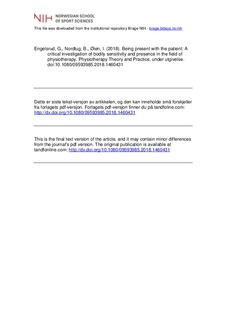| dc.contributor.author | Engelsrud, Gunn | |
| dc.contributor.author | Øien, Ingvil | |
| dc.contributor.author | Nordtug, Birgit | |
| dc.date.accessioned | 2019-04-04T11:10:08Z | |
| dc.date.available | 2019-04-04T11:10:08Z | |
| dc.date.created | 2018-02-06T05:14:09Z | |
| dc.date.issued | 2018 | |
| dc.identifier.citation | Physiotherapy Theory and Practice. 2018, under utgivelse. | nb_NO |
| dc.identifier.issn | 0959-3985 | |
| dc.identifier.uri | http://hdl.handle.net/11250/2593300 | |
| dc.description | I Brage finner du siste tekst-versjon av artikkelen, og den kan inneholde ubetydelige forskjeller fra forlagets pdf-versjon. Forlagets pdf-versjon finner du på tandfonline.com / In Brage you'll find the final text version of the article, and it may contain insignificant differences from the journal's pdf version. The definitive version is available at tandfonline.com | nb_NO |
| dc.description.abstract | This article advocates integrating ideas from phenomenological theory regarding the body with a psychoanalytical theory of language to enrich our understanding of the meaning of bodily presence in the practice of physiotherapy. The authors use this theoretical framework to explore bodily presence as a source for physiotherapists’ professional development. They are using research on children as moving and meaning-producing subjects1 to illustrate the relevance of their perspectives. They argue that the perspectives might contribute to a physiotherapeutic practice that incorporates bodily presence in the professional language in addition to specific methods and techniques. Understanding bodily presence involves the physiotherapist recognizing the Other (i.e., the patient/child) in the present moment and trusting her/his own capacity to become aware of her/his own bodily presence. The authors assert that being aware of one’s own bodily presence enables therapists to develop an appreciation of their own bodies and the bodies of their patients as they are and move in mutual relation to each other. Applying the article’s theoretical framework, the authors consider the body as the starting point for speech,2 and suggest that introducing a richer professional language encourages practitioners to become more aware of the dialectic between body and language: how the body is the anchor for speech and how language influences the experience of the body. | nb_NO |
| dc.language.iso | eng | nb_NO |
| dc.relation.uri | https://www.tandfonline.com/doi/full/10.1080/09593985.2018.1460431 | |
| dc.subject | theory | nb_NO |
| dc.subject | body | nb_NO |
| dc.subject | presence | nb_NO |
| dc.subject | speech | nb_NO |
| dc.subject | experience | nb_NO |
| dc.subject | children | nb_NO |
| dc.subject | physiotherapy | nb_NO |
| dc.title | Being present with the patient : a critical investigation of bodily sensitivity and presence in the field of physiotherapy. | nb_NO |
| dc.title.alternative | Being present with the patient : a critical investigation of bodily sensitivity and presence in the field of physiotherapy. | nb_NO |
| dc.type | Journal article | nb_NO |
| dc.type | Peer reviewed | nb_NO |
| dc.description.version | acceptedVersion | nb_NO |
| dc.source.pagenumber | 10 | nb_NO |
| dc.source.journal | Physiotherapy Theory and Practice | nb_NO |
| dc.identifier.doi | 10.1080/09593985.2018.1460431 | |
| dc.identifier.cristin | 1562205 | |
| dc.description.localcode | Seksjon for kroppsøving og pedagogikk / Department of Physical Education | nb_NO |
| cristin.unitcode | 150,35,0,0 | |
| cristin.unitname | Seksjon for kroppsøving og pedagogikk | |
| cristin.ispublished | true | |
| cristin.fulltext | postprint | |
| cristin.qualitycode | 2 | |
